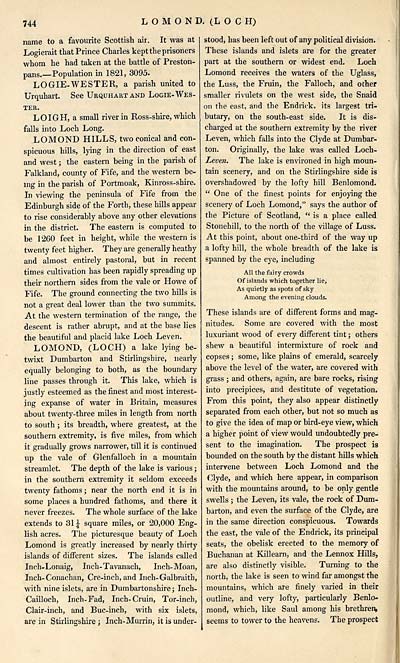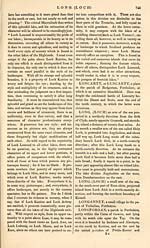Gazetteer of Scotland > Volume 2
(260) Page 744
Download files
Complete book:
Individual page:
Thumbnail gallery: Grid view | List view

744
LOMOND. (LOCH)
name to a favourite Scottish air. It was at
Logierait that Prince Charles kept the prisoners
whom he had taken at the battle of Preston-
pans.— Population in 1821, 3095.
LOGIE- WESTER, a parish united to
Urquhart. See Urquhart and Logie- Wes-
ter.
LOIGH, a small river in Ross-shire, which
falls into Loch Long.
LOMOND HILLS, two conical and con-
spicuous hills, lying in the direction of east
and west ; the eastern being in the parish of
Falkland, county of Fife, and the western be-
ing in the parish of Portmoak, Kinross-shire.
In viewing the peninsula of Fife from the
Edinburgh side of the Forth, these hills appear
to rise considerably above any other elevations
in the district. The eastern is computed to
be 1260 feet in height, while the western is
twenty feet higher. They are generally heathy
and almost entirely pastoral, but in recent
times cultivation has been rapidly spreading up
their northern sides from the vale or Howe of
Fife. The ground connecting the two hills is
not a great deal lower than the two summits.
At the western termination of the range, the
descent is rather abrupt, and at the base lies
the beautiful and placid lake Loch Leven.
LOMOND, (LOCH) a lake lying be-
twixt Dumbarton and Stirlingshire, nearly
equally belonging to both, as the boundary
line passes through it. This lake, which is
justly esteemed as the finest and most interest-
ing expanse of water in Britain, measures
about twenty-three miles in length from north
to south ; its breadth, where greatest, at the
southern extremity, is five miles, from which
it gradually grows narrower, till it is continued
up the vale of Glenfalloch in a mountain
streamlet. The depth of the lake is various ;
in the southern extremity it seldom exceeds
twenty fathoms ; near the north end it is in
some places a hundred fathoms, and there it
never freezes. The whole surface of the lake
extends to 31 \ square miles, or 20,000 Eng-
lish acres. The picturesque beauty of Loch
Lomond is greatly increased by nearly thirty
islands of different sizes. The islands called
Inch-Lonaig, Inch-Tavanach, Inch-Moan,
Inch- Conachan, Cre-inch, and Inch-Galbraith,
with nine islets, are in Dumbartonshire; Inch-
Cailloch, Inch- Fad, Inch-Cruin, Tor-inch,
Clair-inch, and Buc-inch, with six islets,
are in Stirlingshire; Inch- Murrin, it is under-
stood, has been left out of any political division.
These islands and islets are for the greater
part at the southern or widest end. Loch
Lomond receives the waters of the Uglass,
the Luss, the Fruin, the Falloch, and other
smaller rivulets on the west side, the Snaid
on the east, and the Endrick. its largest tri-
butary, on the south-east side. It is dis-
charged at the southern extremity by the river
Leven, which falls into the Clyde at Dumbar-
ton. Originally, the lake was called Loch-
Leven. The lake is environed in high moun-
tain scenery, and on the Stirlingshire side is
overshadowed by the lofty hill Benlomond.
" One of the finest points for enjoying the
scenery of Loch Lomond," says the author of
the Picture of Scotland, " is a place called
Stonehill, to the north of the village of Luss.
At this point, about one-third of the way up
a lofty hill, the whole breadth of the lake is
spanned by the eye, including
All the fairy crowds
Of islands which together lie,
As quietly as spots of sky
Among the evening clouds.
These islands are of different forms and mag-
nitudes. Some are covered with the most
luxuriant wood of every different tint ; others
shew a beautiful intermixture of rock and
copses ; some, like plains of emerald, scarcely
above the level of the water, are covered with
grass ; and others, again, are bare rocks, rising
into precipices, and destitute of vegetation.
From this point, they also appear distinctly
separated from each other, but not so much as
to give the idea of map or bird-eye view, which
a higher point of view would undoubtedly pre-
sent to the imagination. The prospect is
bounded on the south by the distant hills which
intervene between Loch Lomond and the
Clyde, and which here appear, in comparison
with the mountains around, to be only gentle
swells ; the Leven, its vale, the rock of Dum-
barton, and even the surface of the Clyde, are
in the same direction conspicuous. Towards
the east, the vale of the Endrick, its principal
seats, the obelisk erected to the memory of
Buchanan at Killearn, and the Lennox Hills,
are also distinctly visible. Turning to the
north, the lake is seen to wind far amongst the
mountains, which are finely varied in their
outline, and very lofty, particularly Benlo-
mond, which, like Saul among his brethren,
seems to tower to the heavens. The prospect
LOMOND. (LOCH)
name to a favourite Scottish air. It was at
Logierait that Prince Charles kept the prisoners
whom he had taken at the battle of Preston-
pans.— Population in 1821, 3095.
LOGIE- WESTER, a parish united to
Urquhart. See Urquhart and Logie- Wes-
ter.
LOIGH, a small river in Ross-shire, which
falls into Loch Long.
LOMOND HILLS, two conical and con-
spicuous hills, lying in the direction of east
and west ; the eastern being in the parish of
Falkland, county of Fife, and the western be-
ing in the parish of Portmoak, Kinross-shire.
In viewing the peninsula of Fife from the
Edinburgh side of the Forth, these hills appear
to rise considerably above any other elevations
in the district. The eastern is computed to
be 1260 feet in height, while the western is
twenty feet higher. They are generally heathy
and almost entirely pastoral, but in recent
times cultivation has been rapidly spreading up
their northern sides from the vale or Howe of
Fife. The ground connecting the two hills is
not a great deal lower than the two summits.
At the western termination of the range, the
descent is rather abrupt, and at the base lies
the beautiful and placid lake Loch Leven.
LOMOND, (LOCH) a lake lying be-
twixt Dumbarton and Stirlingshire, nearly
equally belonging to both, as the boundary
line passes through it. This lake, which is
justly esteemed as the finest and most interest-
ing expanse of water in Britain, measures
about twenty-three miles in length from north
to south ; its breadth, where greatest, at the
southern extremity, is five miles, from which
it gradually grows narrower, till it is continued
up the vale of Glenfalloch in a mountain
streamlet. The depth of the lake is various ;
in the southern extremity it seldom exceeds
twenty fathoms ; near the north end it is in
some places a hundred fathoms, and there it
never freezes. The whole surface of the lake
extends to 31 \ square miles, or 20,000 Eng-
lish acres. The picturesque beauty of Loch
Lomond is greatly increased by nearly thirty
islands of different sizes. The islands called
Inch-Lonaig, Inch-Tavanach, Inch-Moan,
Inch- Conachan, Cre-inch, and Inch-Galbraith,
with nine islets, are in Dumbartonshire; Inch-
Cailloch, Inch- Fad, Inch-Cruin, Tor-inch,
Clair-inch, and Buc-inch, with six islets,
are in Stirlingshire; Inch- Murrin, it is under-
stood, has been left out of any political division.
These islands and islets are for the greater
part at the southern or widest end. Loch
Lomond receives the waters of the Uglass,
the Luss, the Fruin, the Falloch, and other
smaller rivulets on the west side, the Snaid
on the east, and the Endrick. its largest tri-
butary, on the south-east side. It is dis-
charged at the southern extremity by the river
Leven, which falls into the Clyde at Dumbar-
ton. Originally, the lake was called Loch-
Leven. The lake is environed in high moun-
tain scenery, and on the Stirlingshire side is
overshadowed by the lofty hill Benlomond.
" One of the finest points for enjoying the
scenery of Loch Lomond," says the author of
the Picture of Scotland, " is a place called
Stonehill, to the north of the village of Luss.
At this point, about one-third of the way up
a lofty hill, the whole breadth of the lake is
spanned by the eye, including
All the fairy crowds
Of islands which together lie,
As quietly as spots of sky
Among the evening clouds.
These islands are of different forms and mag-
nitudes. Some are covered with the most
luxuriant wood of every different tint ; others
shew a beautiful intermixture of rock and
copses ; some, like plains of emerald, scarcely
above the level of the water, are covered with
grass ; and others, again, are bare rocks, rising
into precipices, and destitute of vegetation.
From this point, they also appear distinctly
separated from each other, but not so much as
to give the idea of map or bird-eye view, which
a higher point of view would undoubtedly pre-
sent to the imagination. The prospect is
bounded on the south by the distant hills which
intervene between Loch Lomond and the
Clyde, and which here appear, in comparison
with the mountains around, to be only gentle
swells ; the Leven, its vale, the rock of Dum-
barton, and even the surface of the Clyde, are
in the same direction conspicuous. Towards
the east, the vale of the Endrick, its principal
seats, the obelisk erected to the memory of
Buchanan at Killearn, and the Lennox Hills,
are also distinctly visible. Turning to the
north, the lake is seen to wind far amongst the
mountains, which are finely varied in their
outline, and very lofty, particularly Benlo-
mond, which, like Saul among his brethren,
seems to tower to the heavens. The prospect
Set display mode to: Large image | Transcription
Images and transcriptions on this page, including medium image downloads, may be used under the Creative Commons Attribution 4.0 International Licence unless otherwise stated. ![]()
| Gazetteers of Scotland, 1803-1901 > Gazetteer of Scotland > Volume 2 > (260) Page 744 |
|---|
| Permanent URL | https://digital.nls.uk/97433942 |
|---|
| Description | Volume II: Glenbanchor to Zetland. |
|---|---|
| Attribution and copyright: |
|
| Description | By Robert Chambers and William Chambers. Glasgow: Blackie & Son, 1838. 2 volumes. |
|---|---|
| Shelfmark | NF.1461.g.7 |
| Additional NLS resources: | |

